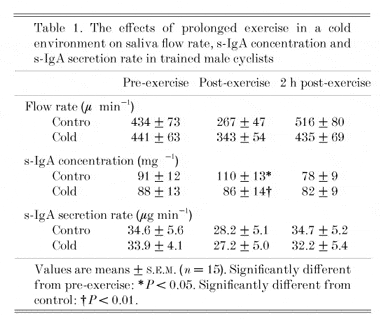Saliva IgA (s-IgA) concentration has been reported to fall temporarily after prolonged continuous exercise (Mackinnon et al. 1987) and this fall has been implicated in the increased incidence of upper respiratory tract infections reported in endurance athletes. Tomasi et al. (1982) suggested that the decrease in s-IgA concentration after a 50 km cross-country ski race might have been partly due to the large inflow of cold air lowering the temperature of the mucous membranes. Housh et al. (1991) showed no effect of exercising in cold conditions on s-IgA concentration, although they only used a 30 min treadmill run and the ambient temperature was above freezing (6 °C). The aim of the present study was to determine the effects of a prolonged bout of exercise in freezing cold conditions on s-IgA concentration and secretion rate in endurance trained males.
With local ethics committee approval, fifteen well trained male cyclists (age 29 ± 2 years, body mass 73.5 ± 1.4 kg, ΩO2,max 62.2 ± 2.4 ml kg-1 min-1, mean ± S.E.M.) volunteered to participate in the study. On two occasions separated by 1 week subjects reported to the laboratory at 12.30 h following a 4 h fast. Subjects cycled for 2 h on a stationary ergometer at 60 % peak power output (199 ± 4 W; 69 ± 2 % ΩO2,max) in an environmental chamber on one occasion at a temperature of -6.4 ± 0.1 °C (cold) and on another occasion at a temperature of 19.8 ± 0.2 °C (control). In both trials subjects wore cycle shorts and jersey. In the cold trial subjects also wore thermal gloves and neoprene overshoes. The order of the trials was randomised. Unstimulated whole saliva samples were collected over a 2 min period into pre-weighed tubes at pre-exercise, post-exercise and 2 h post-exercise. Saliva samples were stored at -40 °C prior to analysis. Saliva volume was estimated by weighing to the nearest milligram and saliva density was assumed to be 1 g ml-1. The s-IgA concentration was determined using a sandwich type ELISA method (Blannin et al. 1998). Saliva IgA secretion rate was calculated by multiplying the saliva flow rate by the IgA concentration. Results were analysed using a two-factor (trial X time) repeated measures ANOVA with post-hoc Tukey and paired t tests applied where appropriate. Statistical significance was accepted at P < 0.05.
Saliva flow rate fell post-exercise returning to pre-exercise levels by 2 h post-exercise (main effect of time: P < 0.01, Table 1). The fall in saliva flow rate post-exercise in the control trial approached significance (interaction: P = 0.08) and may account for the corresponding increase in s-IgA concentration in the control trial at the same time point (P < 0.05, Table 1). No other differences were seen for saliva flow rate, s-IgA concentration or secretion rate. These data suggest that performing prolonged exercise in a cold environment does not influence saliva flow rate or s-IgA secretion rate responses to prolonged exercise.

